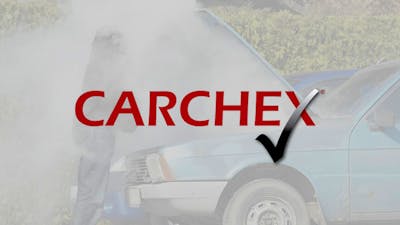How Much Does it Cost to Replace a Radiator?
One job that has thankfully become a less frequent hassle for vehicle owners is replacing the radiator. There was a time (not too long ago) when radiator shops were a thriving cottage industry. Some had great marketing quips, such as “Rogers Radiator: The Best Place In Town To Take a Leak.” While we were friendly with Roger, it’s nice to see that automakers have finally figured out how to make radiators last more than a week past the warranty.
If you found this story online as your ride is being winched up onto a tow truck, you most likely want to know how much it’s going to cost to repair or replace your radiator. A repair can cost a few hours of labor, so figure $300 to $500. A replacement can cost between $700 and $2,500, depending upon your particular car’s make and model and where you have it replaced.
Popular Warranty Providers
What Exactly is a Radiator?
The radiator in your vehicle is a liquid-to-air cooler that helps keep your engine operating at its proper temperature. Most modern internal combustion engine-powered vehicles have radiators. Porsche held out the longest, making air-cooled sports cars long past the rest of the industry's switch.
How Does A Radiator Work?
Your car’s radiator is a long tube coiled up in a rectangular box and connected to metallic heat transfer fins. It’s about two feet to three feet on a side, and it is about three to five inches thick. Almost all vehicle radiators are in the front of the car. A grill on the front of the car lets in air to cool the liquid inside the coils. A fan is located in that same area to help force cooling air over the coils when the vehicle isn’t moving.
The heat is being generated by combustion in your vehicle’s engine. That heat will melt important parts of the engine if it is not kept under control. Channels in the engine let liquid circulate. A reservoir, pump, and thermostat make up the rest of the cooling system. The liquid inside is called coolant, a.k.a. antifreeze.
Why Do I Need a New Radiator?
Radiators are at the front of the vehicle, where they can be impacted by objects. This is very uncommon but not unheard of. If an object strikes and pierces the radiator, it will have a hole that will let out the coolant, and thus the car will overheat. More often, a radiator suffers a failure due to corrosion or a manufacturing defect. Sometimes, the cooling system suffers another failure that then heats up and over pressurizes the radiator, resulting in failure. Modern radiators use both metal and plastic parts. The coolant inside your cooling system is formulated to prevent corrosion.
How Do I Know If My Radiator Needs to be Replaced?
Aside from a mechanic telling you, “You need a new radiator,” there are three main ways to know that your car has a problem with its cooling system. First, you may smell a sweet smell. That’s your coolant vaporizing and becoming a mist of sweet sorrow. Second, you may see vaporized coolant coming from under the hood. (Steam is not visible, though we often call liquid vapor we see “steam”). Third, your vehicle may have either a temperature display or a symbol letting you know the engine is overheating and that you need to stop and deal with the problem or be towed. There is a fourth way to know, but it is rare that anyone lucks out this way. Your vehicle has a coolant reservoir under the hood with a minimum line. If you happen to be poking around under the hood and notice that the reservoir is dry, you may luck out and be able to take action before the coolant has leaked out of the system entirely.
What Should I Do If My High Engine Temperature Light Comes On?
There are lights you can use as a handy heads-up for investigation, and there are lights that mean, “Pull over right now and shut off the engine!” A high-temperature warning light is the second type. By quickly taking action to turn off the vehicle, you may save the engine from major and expensive damage. Find the closest safe place to pull over, and then turn off the vehicle.
NEVER DO THIS
Once you are pulled over, you may be tempted to pop the hood and investigate. After the hood is up, you may see that radiator cap just daring you to open it. Never, ever do that. It may contain steam or high-temperature coolant vapor that can burn you badly. Let the pros take over. Call AAA or your roadside assistance company and tell them your situation. Do not restart the vehicle.
Who Can Repair or Replace My Radiator?
We were not kidding about Roger. His shop is still on Riverside Ave in Medford, but what are the chances you are just north of Boston? Your choices are a local mechanic, a car repair chain, or your dealer. We’d lean toward the local mechanic as the best choice. The dealer can handle this job with ease, but it will likely cost you 25% to 50% more money. If your car is still under warranty, opt for the dealer, of course.
Can My Radiator Be Repaired?
It is possible to repair radiators in some cases. However, sometimes it is not worth the effort financially. A replacement may be the smarter choice. Ask your mechanic for her best advice on this after the issue is diagnosed.
What About Cans of Sealant Fluid?
If you own an old beater that you don’t want to sink a single penny into, there are miracle cures in a bottle that do plug small coolant system holes. Will that stuff also plug the channels in your engine? Will it glue your thermostat open or closed? Will it make your water pump issue forth a screeching death cry? Will it simply drain out onto your driveway? Who knows? Our advice is to never put that stuff into any car you want to keep for more than a week longer.
Can I Simply Put Water Into My Engine and Call It Good?
Small leaks can be managed by topping off coolant levels until you get to the mechanic’s shop. We don't recommend that, but let’s be real: legions of old car owners have been doing it for over a hundred years. Never just use water. It can cause the engine block to freeze and crack. At least buy coolant and get the right type for your specific vehicle.
Can I Fix My Own Radiator?
If you are handy with tools, have some free time, and enjoy the smell of antifreeze, replacing a radiator is within the realm of possibility. Be prepared to disassemble a lot of your vehicle to get at the radiator. And are you certain it is the radiator? Please don't leave coolant on the ground or let it run down drains. We suggest a mechanic, but on a scale of 1 being checking your tire pressure and 10 being a transmission overhaul, replacing a radiator is about a 5.
How Much Will Fixing or Replacing My Radiator Cost?
Your cost to repair or replace your radiator depends on endless factors. Well, a few really. What make and model vehicle you have, where you get it fixed, and how lucky you are with the problem all factor in. A simple repair may cost only a few hours of labor. So, the starting price is around $300. Replacing the radiator in an Audi R8 V10 Spyder may be a bit more like a college tuition payment. We would put the average cost heading into 2024 at around $1,200. Let us know how close we came!
Read more on the topic of Owning a Car here.





















